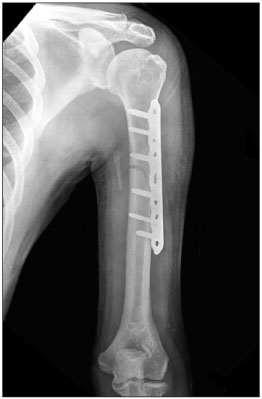J Korean Orthop Assoc.
2010 Dec;45(6):490-495. 10.4055/jkoa.2010.45.6.490.
Treatment of Brachial Artery Injury with Humeral Shaft Fracture Using Endovascular Stenting
- Affiliations
-
- 1Department of Orthopedic Surgery, Dongguk University College of Medicine, Gyeongju, Korea. kjpil@dongguk.ac.kr
- 2Department of Internal Medicine, Dongguk University College of Medicine, Gyeongju, Korea.
- KMID: 2185498
- DOI: http://doi.org/10.4055/jkoa.2010.45.6.490
Abstract
- An injury to the brachial artery from humeral shaft fracture is uncommon but requires immediate surgery to restore the blood flow. We report a case of endovascular stenting to repair a brachial artery occlusion caused by humeral shaft fracture in a 53 year old male with a review of the relevant literature.
MeSH Terms
Figure
Reference
-
1. Winkelaar GB, Taylor DC. Vascular trauma associated with fractures and dislocations. Semin Vasc Surg. 1998. 11:261–273.2. Hasan SA, Cordell CL, Rauls RB, Eidt JF. Brachial artery injury with a proximal humerus fracture in a 10-year-old girl. Am J Orthop (Belle Mead NJ). 2009. 38:462–466.3. Gainor BJ, Metzler M. Humeral shaft fracture with brachial artery injury. Clin Orthop Relat Res. 1986. 204:154–161.
Article4. Hunt CA, Kingsley JR. Vascular injuries of the upper extremity. South Med J. 2000. 93:466–468.
Article5. Zellweger R, Hess F, Nicol A, Omoshoro-Jones J, Kahn D, Navsaria P. An analysis of 124 surgically managed brachial artery injuries. Am J Surg. 2004. 188:240–245.
Article6. McHenry TP, Holcomb JB, Aoki N, Lindsey RW. Fractures with major vascular injuries from gunshot wounds: implications of surgical sequence. J Trauma. 2002. 53:717–721.
Article7. Chander RK, Lyon RT, Romano AE, et al. Novel endovascular techniques for repair of traumatic bilateral axillary artery disruption with long-term follow-up. Ann Vasc Surg. 2010. 24:551.
Article8. Kelly D, Levy T, Talwar S. Brachial artery perforation repaired with percutaneous transfemoral covered stent deployment in a patient on abciximab. J Invasive Cardiol. 2008. 20:E82–E83.9. Maynar M, Baro M, Qian Z, et al. Endovascular repair of brachial artery transection associated with trauma. J Trauma. 2004. 56:1336–1341.
Article10. Xenos ES, Freeman M, Stevens S, Cassada D, Pacanowski J, Goldman M. Covered stents for injuries of subclavian and axillary arteries. J Vasc Surg. 2003. 38:451–454.
Article
- Full Text Links
- Actions
-
Cited
- CITED
-
- Close
- Share
- Similar articles
-
- Delayed Brachial Artery Occlusion after Humeral Shaft Open Fracture: A Case Report
- Operative Treatment of the Humeral Shaft Fracture
- Dislocation of the Shoulder with Ipsilateral Humeral Shaft Fracture: A Case Report
- Humerus Shaft Fractures in Leisure Sport 'Flyfish Riding': 4 Cases Report
- Throwing Induced Non-stress Humeral Shaft Fracture: A Case Report










